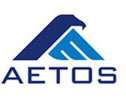Aetos Security Management
Coordinates: 1°19′49.26″N 103°50′11.84″E / 1.3303500°N 103.8366222°E
 | |
| Subsidiary | |
| Industry | Security |
| Founded | merger of Auxiliary Police Forces of PSA Corporation, ST Kinetics and Changi International Airport Services |
| Headquarters | Singapore |
Key people |
James Tan Chan Seng, Executive Director/CEO DAC (APF) Tan Chong Hee, AETOS Commander |
| Parent | Temasek Holdings (100%) |
| Website | www.aetos.com.sg |


AETOS Security Management, a wholly owned subsidiary of Temasek Holdings, provides total security solutions and security services to a wide range of clientele.
Established in 2004, AETOS began operations following the merger of the Auxiliary Police Forces of PSA Corporation Ltd, Singapore Technologies Kinetics Ltd (ST Kinetics) and Changi International Airport Services Pte Ltd (CIAS). This brought together the country's security units in maritime, key installations protection and aviation under one roof.
History
Origins
AETOS was established in February 2004. Since its establishment, it has merged the Auxiliary Police forces of CIAS, PSA Corporation and ST Kinetics as a result of an amalgamation exercise initiated by Temasek Holdings..
Diversification
In 2006, AETOS Security Management formed two wholly owned subsidiary, AETOS Security Consultants, and AETOS Security Training and Consultancy, to meet their broadened scope of unarmed business and training and consultancy business.
Personnel
The first General Manager was BG(Ret) Andrew Tan (2004–2005). He was followed by Mr Kelvin Tan (2005–2008). This position was re-designated as Executive Director in 2008, when Mr Chua Chin Kiat took over. The current Executive Director and CEO is Mr James Tan Chan Seng, the former Commissioner of the Singapore Civil Defence Force.[1]
Organization Structure
The team comprises officers from the police force, military and public service entities. AETOS' armed and unarmed officers can be seen securing Singapore's airports, ports, key and strategic installations, as well as regional and local businesses and events.
Deployments
Some deployment sites of armed and unarmed Aetos Security professionals include:
- Esplanade - Theatres on the Bay
- Singapore Cruise Centre
- Police Cantonment Complex
- Singapore Changi Airport (providing part of the airside services)
- Woodlands Checkpoint
- Changi Prison
- Jurong Island Checkpoint
Events
Major events secured by armed and unarmed Aetos Security professionals include:
- Marina Bay Countdown Celebration
- Chingay Parade
- Singapore F1 Grand Prix
- IISS Forum
- Singapore Airshow
- SEA Games 2015
Uniforms
When AETOS was incorporated on 1 Apr 2004, AETOS officers continued to wear uniforms worn by officers from the antecedent Auxiliary Police Forces, namely Port of Singapore Authority Police (PSAP), Singapore Technologies Kinetics Police (STKP) and Changi International Airport Services Police (CIASP). Under governmental direction, the uniform was modified to inject distinguishing features between them and that of those worn by officers of the Singapore Police Force to foster a more level playing field with other Auxiliary Police Forces in Singapore.
The new uniforms were a new corporate colour, tartan blue, and the material was pure polyester to poly viscose. New buttons and badges on the cap and collars incorporating AETOS's logo were used in place of similar logos to the Singapore Police Force.
Given its former affiliation with the Singapore Police Force, AETOS officers wore tartan blue uniform similar in design of the police force when the antecedent auxiliary police forces, PSA Police, STK Police and CIAS Police formed in 1947, 1967 and 1981 respectively. Uniforms were kept similar such that the general public would not be able to tell AETOS officers from regular police officers unless under close scrutiny. The primary distinguishing feature was the tartan top.
As a result of several uniform reviews both by the police and SIRD, Auxiliary Police Forces must don uniforms with distinctive differences with their regular counterparts. AETOS retained the old metallic cap badges and collar lapels although they were replaced with embroidered versions in the SPF. AETOS officers also don berets and box caps, depending on the security requirements of the clients and the operating environment.